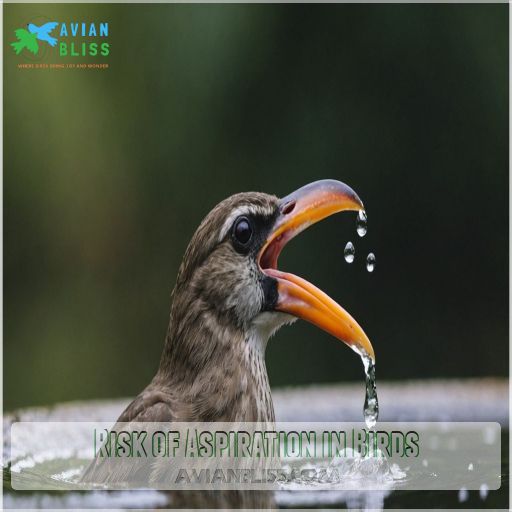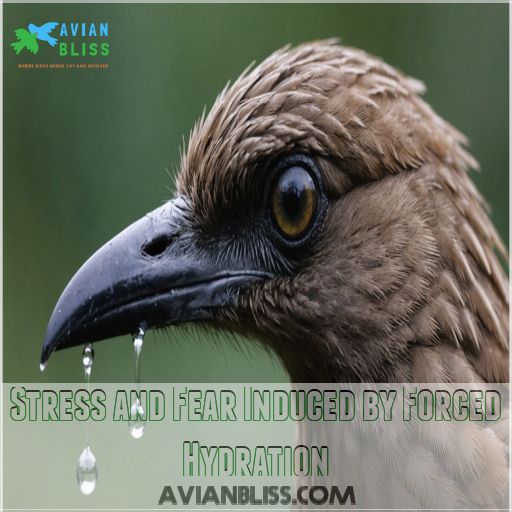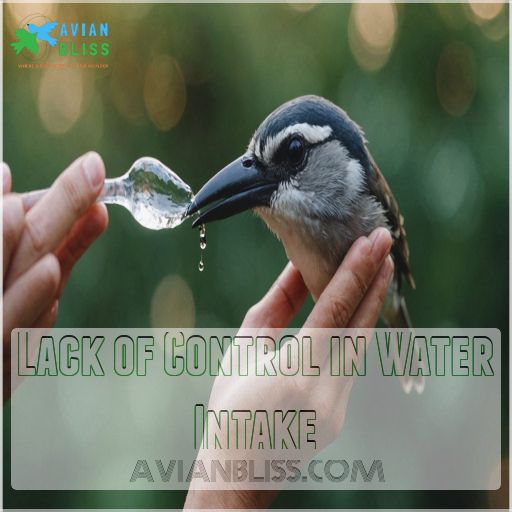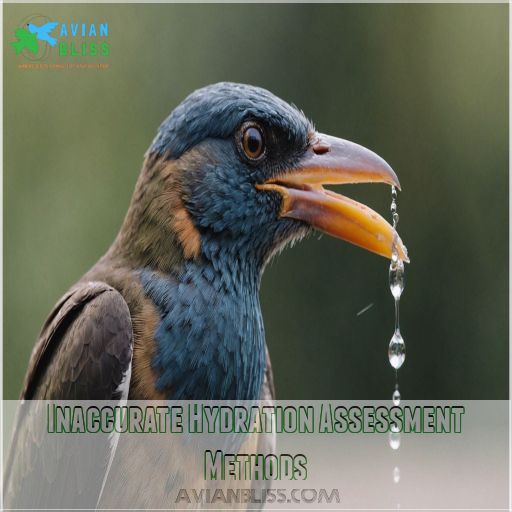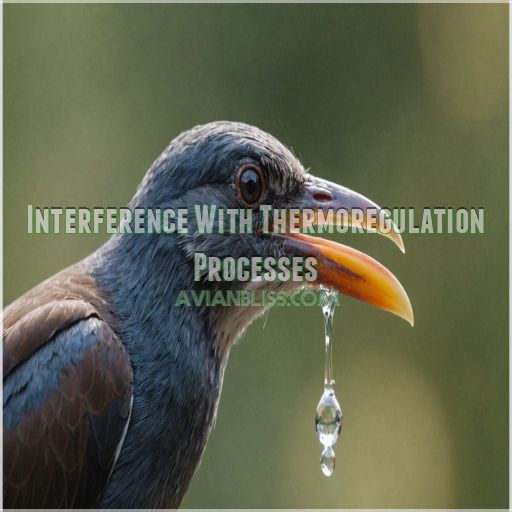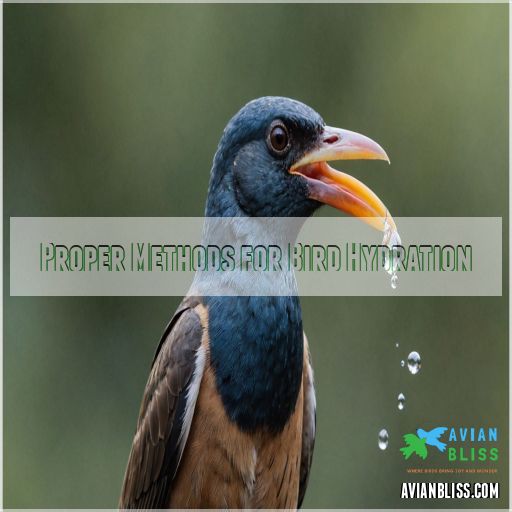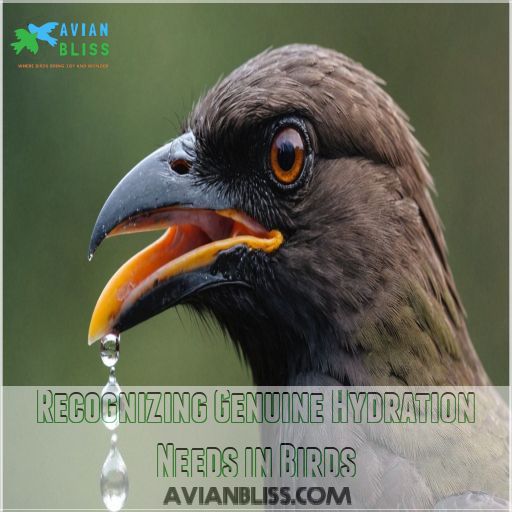This site is supported by our readers. We may earn a commission, at no cost to you, if you purchase through links.
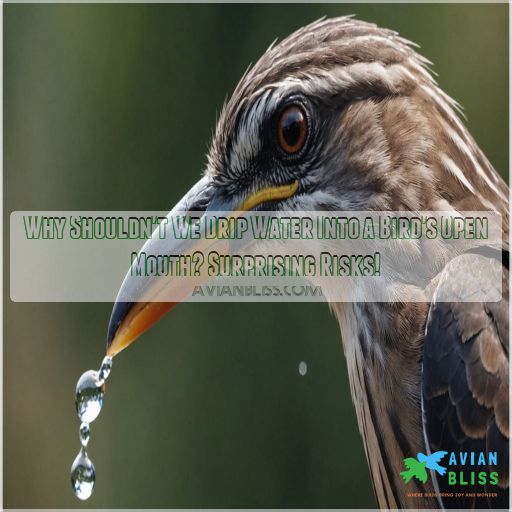 You might think you’re helping, but dripping water into a bird’s open mouth is a big no-no! Birds have a unique swallowing mechanism, and their trachea (breathing tube) is super close to their esophagus (food tube).
You might think you’re helping, but dripping water into a bird’s open mouth is a big no-no! Birds have a unique swallowing mechanism, and their trachea (breathing tube) is super close to their esophagus (food tube).
When you force water in, you’re basically playing a risky game of "which tube will it choose?" Spoiler alert: if it goes down the wrong pipe, you’re looking at potential choking, respiratory distress, or even pneumonia.
Plus, you’re disrupting their natural drinking behavior and potentially stressing them out. It’s like trying to force-feed a toddler – messy, stressful, and potentially dangerous.
But don’t worry, there are safer ways to keep our feathered friends hydrated.
Table Of Contents
- Key Takeaways
- Risk of Aspiration in Birds
- Disruption of Natural Drinking Behaviors
- Stress and Fear Induced by Forced Hydration
- Lack of Control in Water Intake
- Inaccurate Hydration Assessment Methods
- Interference With Thermoregulation Processes
- Obstruction of Respiratory Functions
- Interference With Communication Signals
- Proper Methods for Bird Hydration
- Recognizing Genuine Hydration Needs in Birds
- Frequently Asked Questions (FAQs)
- Why do birds open their mouths?
- How does temperature affect bird mouth opening behavior?
- Why do birds open their mouths in hot climates?
- How do birds get water?
- Can you pour water in a birds mouth?
- Why not to give water to injured bird?
- Why you shouldn’t give birds water?
- Why would a bird keep its mouth open?
- Can bird baths spread diseases among birds?
- Do birds feet freeze on metal perches?
- How often should hummingbird feeders be cleaned?
- Is red food coloring necessary for hummingbird nectar?
- How does fruit help birds during hot weather?
- Conclusion
Key Takeaways
- You might think you’re playing superhero, but forced hydration is more villain than hero. Birds have a unique swallowing mechanism that’s easily disrupted, potentially leading to choking or respiratory distress. It’s like trying to drink while doing a handstand – not a recipe for success.
- That open beak isn’t always a cry for water. Birds use mouth-opening for various reasons, from cooling down to showing aggression. Misinterpreting these signals is like assuming every yawn means someone is bored – you might be barking up the wrong tree.
- You’re not just quenching thirst; you’re messing with Mother Nature’s air conditioning. Birds rely on open-mouth breathing to regulate their body temperature. By interfering, you’re essentially unplugging their natural cooling system – talk about a case of good intentions gone awry.
- Instead of playing bird dentist, set up a backyard oasis. Provide clean, accessible water sources and let our feathered friends drink on their own terms. It’s like hosting a bird spa – they’ll appreciate the five-star treatment without the unwanted mouth massage.
Risk of Aspiration in Birds
You might think you’re helping a thirsty bird by dripping water into its open mouth, but this well-intentioned act can actually be dangerous.
Birds have a unique swallowing mechanism that makes them vulnerable to aspiration, which can lead to serious health issues or even death.
Unique Bird Swallowing Mechanism
Through the looking glass of avian anatomy, you’ll find birds have a unique swallowing mechanism that’s quite different from ours.
Their swallowing process is a delicate dance of:
- Tilting the head back
- Using gravity to guide food
- Rapid throat contractions
This intricate system isn’t designed for direct water input. When you drip water into a bird’s open mouth, you’re basically asking it to perform an underwater ballet . It’s like trying to drink while doing a handstand!
Proximity of Trachea and Esophagus
Inside a bird’s delicate neck, the trachea and esophagus are closer neighbors than you might think.
Unlike mammals, birds have these important tubes nestled side by side on the right side of their neck . This cozy arrangement is nature’s way of accommodating their flexible necks.
This unique anatomy is a double-edged sword. When you’re trying to help a thirsty feathered friend, this proximity can turn a well-meaning gesture into an accidental waterboarding session.
Potential for Water Entering Trachea
Almost all birds have a unique anatomical quirk that puts them at risk when you’re trying to help.
Their trachea and esophagus are joined together on the right side of the neck .
This means when you drip water into a bird’s open mouth, it’s like playing anatomical roulette.
You might accidentally send that well-intentioned drink down the wrong pipe, potentially causing serious breathing issues.
Respiratory Complications From Aspiration
Aspiration in birds isn’t just a drop in the bucket – it can lead to serious respiratory complications.
When water enters a bird’s trachea, it’s like throwing a wrench in their delicate breathing system.
- Pneumonia
- Respiratory infections
- Airway inflammation
You might think you’re helping, but forcing water into a bird’s open mouth can backfire. It’s like trying to feed a fish out of water – it goes against their natural anatomy and can leave them gasping for air.
Choking Hazards and Respiratory Distress
You might think dripping water into a bird’s open mouth is helpful, but it’s a recipe for disaster.
Birds have a unique anatomy that makes them prone to choking and respiratory distress when water enters their airway (Source).
Even a small amount can obstruct their delicate respiratory system, leading to panic and potentially life-threatening complications.
It’s like trying to drink while upside down – not a good idea!
Disruption of Natural Drinking Behaviors
You might think you’re helping a thirsty bird by dripping water into its open mouth, but you’re actually disrupting its natural drinking behaviors.
Birds have evolved specific ways to drink that are essential for their health and well-being, and interfering with these instincts can lead to some surprising risks, as they can impact their overall health and well-being.
Evolved Drinking Mechanisms in Birds
Throughout millennia, birds have fine-tuned their drinking techniques to perfection.
Their beaks aren’t just for chirping and pecking – they’re marvels of evolutionary engineering .
These feathered friends have developed specialized mechanisms for sipping water, adapting to various environmental pressures.
From tip-up to tip-down drinking, each species has its own unique approach, honed by nature to efficiently quench their thirst.
Head-lifting Instinct for Swallowing
Birds have a nifty trick up their feathery sleeves when it comes to drinking.
When you see a bird tilt its head back after sipping water, it’s not just showing off its profile.
This head-lifting instinct is a key part of their swallowing mechanism.
It’s like nature’s built-in water slide, helping the liquid glide down smoothly and efficiently into their crop.
Importance of Natural Drinking Motion
Everyone knows that birds have their own way of doing things, and drinking is no exception. The natural drinking motion isn’t just a quirky habit – it’s a key instinct that’s deeply ingrained into their tiny bird brains.
When we interfere with this process, we’re basically asking them to ignore millions of years of evolution. It’s like trying to teach a fish to climb a tree!
This is similar to how birds use their beaks to connect with their environment and people they trust, such as beak rubbing as affection.
By respecting their natural behaviors, we can help reduce stress and potential health risks.
- Respects the bird’s innate wisdom
- Allows for proper water intake control
- Reduces stress and potential health risks
Physiological Benefits of Natural Drinking
When you let birds drink naturally, you’re doing more than quenching their thirst — you’re supporting their overall health.
Natural drinking motions help birds regulate their water intake, keeping them perfectly hydrated . This instinctive process also aids in digestion and nutrient absorption.
Plus, it’s a mini workout for their neck muscles!
By respecting their natural drinking habits, you’re helping our feathered friends stay in tip-top shape.
Potential Negative Impacts of Forced Drinking
Forcing water into a bird’s mouth can be a recipe for disaster. While your intentions may be good, this approach disrupts natural drinking behaviors and can lead to serious issues.
- Increased stress and fear
- Potential for aspiration and choking
- Erosion of trust between you and the bird
Remember, birds have evolved specific drinking behaviors that involve head-lifting . Interfering with this natural process may cause more harm than good.
Stress and Fear Induced by Forced Hydration
You might think you’re helping a thirsty bird by dripping water into its open beak, but this well-intentioned act can actually cause more harm than good.
Let’s explore why forced hydration can be a stressful and frightening experience for our feathered friends.
Potentially damaging their trust in humans and even leading to long-term behavioral issues.
Bird Responses to Direct Water Sources
While you might think birds would readily accept water, their responses can be surprising. When faced with direct water sources, our feathered friends often react with caution or even fear.
Let’s explore why:
| Bird Type | Natural Drinking | Forced Drinking |
|---|---|---|
| Waterfowl | Dip and sip | May panic |
| Songbirds | Tilt head back | Could choke |
| Hummingbirds | Lap with tongue | Risk aspiration |
| Raptors | Gulp from prey | Stress response |
| Parrots | Scoop with beak | Potential trauma |
Remember, birds have evolved specific drinking mechanisms . Respecting these instincts keeps our avian pals safe and stress-free!
Stress-related Health Complications
The hidden dangers of forced hydration can ruffle more than just feathers.
Your feathered friend might experience a whirlwind of stress-related health issues. From feather plucking to anxious behaviors, these complications can leave your bird in a flap.
Just like us, birds thrive on feeling safe and in control.
By respecting their natural drinking habits, you’re not just quenching their thirst – you’re nurturing their overall well-being.
Impact on Bird-human Trust Relationships
Dripping water into a bird’s mouth can shatter the delicate trust between you and your feathered friend.
Just like you wouldn’t appreciate someone forcing food down your throat, birds value their autonomy too.
This well-intentioned act might leave your bird feeling betrayed, leading to a breakdown in your bond.
Remember, trust is like a house of cards – easy to topple, hard to rebuild.
Potential for Injury From Frightened Reactions
You might think you’re helping, but forcing water into a bird’s mouth can backfire big time.
When startled, birds may:
- Flap wildly, risking wing injuries
- Bite defensively, hurting themselves or you
- Aspirate water, leading to respiratory distress
These panicked reactions aren’t just scary – they can cause real harm.
Remember, birds are delicate creatures . Your well-meaning gesture could accidentally hurt the very animal you’re trying to save.
Let’s explore safer ways to help our feathered friends stay hydrated!
Long-term Behavioral Effects of Forced Hydration
Frightened reactions aren’t the end of the story.
Forced hydration can leave lasting scars on a bird’s psyche. You might think you’re helping, but you’re actually teaching your feathered friend to fear human hands.
This stress response can lead to learned avoidance behaviors, making future care challenging.
It’s like trying to befriend someone by constantly throwing water in their face – not exactly a recipe for trust!
Lack of Control in Water Intake
You might think you’re helping a thirsty bird by dripping water into its open beak, but this well-intentioned act can actually be dangerous.
Lack of control in water intake is a serious risk that can lead to overhydration, choking, and other health issues for our feathered friends.
Risks of Uncontrolled Water Administration
Forced hydration can be a slippery slope. When you’re in control of the water flow, it’s easy to misjudge how much is too much.
- Birds can’t communicate when they’ve had enough
- You might accidentally give more than they need
- It’s hard to gauge the right amount for different species
Remember, birds are like nature’s own sippy cups – they’ve got their drinking down to a science . Let’s not muddy the waters of their natural instincts!
Potential for Overhydration
When you’re overenthusiastic about hydrating your feathered friend, you might accidentally go overboard.
Just like us, birds can suffer from water toxicity if they consume too much.
This can lead to their delicate fluid balance being thrown out of whack, potentially leading to kidney issues and electrolyte imbalances.
It’s like trying to fill a tiny teacup with a fire hose – you’ll end up with more of a mess than a refreshed birdie!
Difficulty in Assessing Appropriate Water Volume
Determining the right amount of water for a bird isn’t as simple as it sounds. You might think you’re helping, but it’s tricky to gauge how much they actually need.
Birds have unique hydration requirements that vary by:
- Species
- Size
- Environmental conditions
Overhydration can be just as dangerous as dehydration . Instead of playing guessing games with your feathered friend’s water intake, it’s best to provide fresh water daily and let them drink naturally .
Choking Risks From Excessive Water
The delicate balance of hydration can quickly tip into danger when you’re giving water to a bird.
You might think you’re helping, but too much water can be a real choking hazard. It’s like trying to drink from a fire hose – overwhelming and potentially harmful.
Birds need just a few drops at a time, with a pigeon only requiring 50-80ml per day . Overdo it, and you risk turning a kind gesture into a risky situation.
Importance of Bird-controlled Drinking
Birds know best when it comes to sipping water. You wouldn’t want someone forcing you to drink, right?
The same goes for our feathered friends. Letting birds control their water intake is really important for their well-being.
They’ve got their own unique way of drinking that keeps them safe and healthy. By providing accessible water sources, you’re empowering birds to quench their thirst on their terms, reducing stress and potential health risks .
This approach also enables birds to drink on their terms, which is essential for their overall well-being.
Inaccurate Hydration Assessment Methods
You might think you’re helping a thirsty bird by dripping water into its open beak, but this well-intentioned act can actually do more harm than good.
Let’s explore why this method of hydration is inaccurate and potentially dangerous for our feathered friends.
Challenges in Determining Bird Hydration Needs
You might think figuring out a bird’s thirst level is a walk in the park, but it’s more like figuring out a maze blindfolded! Determining avian hydration needs can be tricky, even for seasoned bird lovers.
- Birds are masters at hiding illness (Source)
- Hydration needs vary widely among species
- Environmental factors play a huge role
Understanding your feathered friend’s unique requirements is key to keeping them healthy and chirpy!
Risks of Underhydration or Overhydration
If you’re thinking about bird hydration, you’re walking a tightrope. Underhydration can lead to low blood pressure and organ dysfunction , while overhydration risks hyponatremia, a dangerous electrolyte imbalance.
It’s a delicate balance that’s tough to nail without proper knowledge. Unlike humans, birds don’t always show clear signs of thirst, making it challenging to gauge their needs accurately.
Remember, what works for your pet parakeet mightn’t suit a wild hawk, illustrating the importance of understanding the specific needs of a wild hawk.
Natural Drinking Cues in Birds
Understanding natural drinking cues in birds is like decoding a secret language.
While you might think an open beak means thirst, it’s not always the case. Birds have unique ways of signaling their hydration needs. From specific head movements to subtle changes in preening behavior, these feathered friends communicate their thirst in ways you mightn’t expect.
Learning to read these cues can help you provide better care for your avian companions, such as recognizing that they typically need to drink water 2-3 times a day and consumption of water daily.
Importance of Observing Natural Drinking Behavior
Watching a bird’s natural drinking behavior is like being a detective on a hydration case.
It’s not just about seeing them sip; it’s about understanding their unique needs. By observing how often they visit water sources and how they approach them, you’ll get a bird’s-eye view of their hydration habits.
This keen observation helps you provide the right amount of water without playing guessing games .
Alternative Methods for Assessing Bird Hydration
Instead of forcing water into a bird’s beak, you’ve got better ways to check if your feathered friend needs a drink.
Keep an eye on their dropping behavior – it’s like a tiny health report!
Weighing your bird regularly can also reveal hydration issues. Don’t forget to feel their feathers; they should be smooth and sleek.
Fecal consistency and overall bird behavior are telltale signs too. It’s like being a bird detective, but way more fun! (Source)
Interference With Thermoregulation Processes
You might think you’re helping a bird cool off by dripping water into its open mouth, but you could actually be doing more harm than good.
Birds have a unique way of regulating their body temperature, and interfering with this process can lead to some surprising risks.
Role of Mouth Opening in Heat Dissipation
Through their open mouths, birds have a clever trick up their sleeves for beating the heat. When temperatures soar, our feathered friends use this natural air conditioning system to cool down.
- Gular fluttering: Birds rapidly vibrate their throat muscles
- Panting: They breathe quickly with open beaks
- Evaporative cooling: Moisture evaporates from their mouths
This process, akin to a dog’s panting but more efficient, helps birds regulate their body temperature without losing precious fluids.
Importance of Beak Exposure for Cooling
You might be surprised to learn that a bird’s beak is its built-in air conditioner. When birds need to cool down, they rely on their beaks to release excess heat.
Let’s take a closer look at how different beak sizes help birds beat the heat:
| Beak Size | Cooling Capacity | Example Species |
|---|---|---|
| Large | High | Toucans |
| Medium | Moderate | Parrots |
| Small | Low | Finches |
Larger beaks allow for greater heat dissipation, which is why you’ll often see birds from warmer climates sporting bigger bills.
Impact on Blood Vessel Heat Exchange
Dripping water into a bird’s open mouth can throw a wrench in their delicate cooling system.
Birds have a nifty trick up their sleeves – they use blood vessel dilation in their bills to help regulate body temperature . By interfering with this process, you’re basically messing with their internal thermostat.
It’s like trying to cool down your car by blocking the radiator – not a great idea, similar to trying to cool down your car by blocking the radiator, which is essentially creating a problem with their delicate cooling system.
Disruption of Natural Cooling Mechanisms
Birds have evolved clever cooling tricks to beat the heat.
When you see a bird with its beak open, it’s not begging for water – it’s trying to cool down.
This behavior, called gular fluttering, helps birds release heat by vibrating their neck muscles.
By dripping water into their mouths, you’re unintentionally blocking this natural air conditioning system.
Let’s not ruffle their feathers when they’re just trying to chill!
Potential for Overheating Due to Interference
When a bird’s panting, it’s not just putting on a show – it’s nature’s air conditioning in action! Blocking this process by dripping water into their beaks can backfire, leading to overheating. Think of it like trying to cool down while someone’s holding your nose – not fun, right?
- Their body temperature rises rapidly
- Stress levels skyrocket, causing panic
- Energy is wasted on ineffective cooling attempts
- Respiratory issues may develop, making matters worse
Instead of playing bird dentist, let’s keep our feathered friends cool the natural way.
Obstruction of Respiratory Functions
You might think you’re helping a thirsty bird by dripping water into its open beak, but you could actually be putting its life at risk.
Birds rely on their beaks for more than just eating and drinking – they play a key role in breathing and maintaining energy levels.
Beak’s Role in Bird Respiration
A bird’s beak isn’t just for eating – it’s their lifeline to oxygen. You might be surprised to learn that birds breathe through small openings in their beaks called nares.
These nares are the gateway to a super-efficient respiratory system that keeps our feathered friends soaring high.
Unlike us, birds have a one-way airflow system that maximizes oxygen intake, essential for powering those impressive flight muscles, which relies on the efficient use of oxygen intake.
Importance of Unobstructed Air Intake
After learning about a bird’s beak and breathing, let’s talk about why they need clear airways. You wouldn’t want someone blocking your nose while you’re trying to catch your breath, right? Birds are no different. They rely on unobstructed air intake for proper respiration.
- Efficient cooling through open-mouth breathing
- Quick oxygen intake during flight
- Proper vocalization for communication
Imagine trying to sing with a straw in your mouth – that’s how a bird feels with blocked airways!
Effects on Oxygen Absorption Efficiency
Your feathered friend’s beak isn’t just for eating – it’s a key part of their respiratory system.
When you drip water into a bird’s open mouth, you’re inadvertently blocking their airway. This can really impact oxygen absorption efficiency .
Birds have a unique respiratory system with air sacs that help them extract more oxygen from each breath.
By obstructing their beak, you’re throwing a wrench in this finely-tuned breathing machine.
Potential for Respiratory Distress
Dripping water into a bird’s open mouth can lead to serious respiratory distress related to bird breathing heavily
. You might think you’re helping, but you’re actually putting your feathered friend at risk.
Birds have a delicate respiratory system that’s easily compromised. When water enters the trachea instead of the esophagus, it can cause:
- Coughing and wheezing
- Labored breathing
- Gurgling sounds
- Head-shaking to dislodge fluid
- Frantic attempts to clear airways
This can quickly escalate to a life-threatening situation, with birds struggling to breathe and potentially suffocating . It’s not worth the risk!
Impact on Overall Bird Energy Levels
When a bird’s respiratory functions are obstructed, it’s not just about breathing – it’s a full-body energy crisis! Think of it like trying to run a marathon while breathing through a straw.
Your metabolic rate skyrockets, flight efficiency plummets, and stress levels soar.
This respiratory roadblock can even impact food intake and digestion. Remember, for birds, every breath counts for their high-energy lifestyle.
Interference With Communication Signals
You might think you’re helping a bird by dripping water into its open mouth, but you could be disrupting its important communication signals.
An open beak isn’t always a sign of thirst – it can mean anything from aggression to hunger, and interfering can lead to misunderstandings between birds and humans alike.
Mouth Opening as Aggression or Hunger Cue
Birds have a secret language, and an open mouth isn’t always an invitation for a drink. It’s often a powerful communication tool.
When you see a bird with its beak agape, it might be:
- Showing dominance or aggression
- Signaling hunger, especially in chicks
- Attempting to regulate body temperature
- Participating in social bonding activities
Understanding these cues helps you avoid misinterpreting your feathered friend’s needs. Remember, in the bird world, actions speak louder than chirps!
Misinterpretation of Bird’s Open Mouth
You might think a bird’s open mouth is an invitation for a drink, but that’s not always the case. Birds use their beaks to communicate in various ways, and misinterpreting these signals can lead to unintended consequences.
Let’s break down some common open-mouth behaviors and what they really mean:
| Behavior | Meaning | Your Response | Potential Risk |
|---|---|---|---|
| Panting | Cooling down | Provide shade | Unnecessary hydration |
| Wide open, still | Aggression | Give space | Stress or bite |
| Slight open, quiet | Relaxed | Observe | Disturbing rest |
| Rapid opening/closing | Stress | Remove stressor | Worsening condition |
Understanding these cues helps you respond appropriately, keeping our feathered friends happy and healthy.
Disruption of Parent-chick Feeding Signals
Baby birds rely on a complex system of signals to communicate their hunger to their parents.
When you drip water into a chick’s open mouth, you’re inadvertently disrupting this delicate dance.
Chicks instinctively pop up with open mouths when they feel the "bounce" of a parent arriving at the nest.
By interfering, you’re potentially confusing both the chicks and parents, which could lead to feeding issues and hinder the important parent-chick bond through disrupting this delicate dance.
Impact on Social Interactions Among Birds
Interfering with a bird’s open mouth can throw a wrench in their social dynamics.
Just like we use facial expressions, birds rely on beak positions to communicate. When you drip water into their mouths, you’re inadvertently messing with their "bird language."
This can disrupt important interactions, from establishing pecking orders to courting potential mates.
It’s like putting duct tape over someone’s mouth mid-conversation – not exactly conducive to smooth social interactions, similar to using duct tape.
Potential for Miscommunication With Humans
Opening a bird’s mouth for water can lead to a breakdown in trust between you and your feathered friend.
Birds communicate through various behaviors, including beak movements. In some cases, these beak movements may be indicative of regurgitation or hunger signals, so you need to understand their meaning to avoid misinterpretation.
When you interfere with their natural communication, you’re basically talking over them in bird language! This miscommunication can strain your relationship, making future interactions more challenging.
Remember, birds are masters of body language – let’s not get our wires crossed in translation!
Proper Methods for Bird Hydration
You might think dripping water into a bird’s open mouth is helpful, but it’s actually quite risky.
Let’s explore safer, more natural ways to keep our feathered friends hydrated that won’t ruffle their feathers or put their health in danger.
Providing Accessible Water Sources
Instead of forcing water into a bird’s beak, let’s explore safer ways to quench their thirst.
You’ll want to set up accessible water sources that birds can use on their own terms.
Place birdbaths in shady, open areas near shrubs or trees . This gives birds a quick escape route if they feel threatened.
For ground-level drinkers, try using an upside-down trash can lid as a simple water bowl.
Importance of Clean, Fresh Water
You’d be amazed at how important clean, fresh water is for our feathered friends.
It’s not just about quenching their thirst; it’s a lifeline for their overall well-being.
To keep your backyard birds happy and healthy, remember these key points:
- Refresh water every 2-4 days (daily in extreme weather)
- Use a vinegar solution for quick, easy cleaning
- Avoid mosquito-breeding by regular changes
- Consider a solar bubbler for moving water
- Scrub thoroughly every 3-5 days, depending on weather
Optimal Placement of Water Containers
Now that you’ve got fresh water ready, let’s place it just right for our feathered friends. Think of it as setting up a bird-friendly café!
| Location | Height | Safety |
|---|---|---|
| Shaded | Low for ground feeders | Away from predators |
| Near cover | Elevated for perching birds | Stable surface |
| Multiple spots | Varied heights | Non-slip base |
| Visible | Accessible to all sizes | Protected from contaminants |
Remember, a partially sunny spot with afternoon shade works best, especially in warmer climates . It’s like finding the perfect patio for your avian guests!
Encouraging Natural Drinking Behaviors
To encourage natural drinking behaviors in birds, think like a feathered friend! Place water sources in shady, open areas near perches . Birds love to dunk their food, so position dishes away from perches to keep them clean.
Some birds prefer warm water, so experiment with temperatures. Ground-level options are also essential for earthbound sippers.
Remember, fresh is best – change water regularly to keep your backyard oasis inviting! By doing so, you will create a welcoming environment for birds, which is also a backyard oasis.
Monitoring Water Intake Without Interference
While encouraging natural drinking is key, keeping tabs on your feathered friend’s water intake doesn’t mean hovering like a helicopter parent.
Instead, become a hydration detective! Place water dishes strategically around your bird’s habitat and watch for telltale signs of drinking.
You’ll get a bird’s-eye view of their habits without ruffling any feathers. It’s like being a nature documentarian in your own home!
Recognizing Genuine Hydration Needs in Birds
You might think you’re helping a bird by dripping water into its open mouth, but this seemingly kind act can actually be dangerous.
Understanding the genuine hydration needs of birds is essential for their well-being.
Recognizing the signs of dehydration is also crucial for their safety.
Signs of Dehydration in Birds
After mastering proper hydration methods, it’s time to sharpen your bird-watching skills.
Recognizing dehydration in your feathered friends is like solving a mini-mystery. Keep your eyes peeled for these telltale signs:
- Droopy eyes that look like they’ve pulled an all-nighter
- Ruffled feathers, as if your bird’s just rolled out of bed
- A sunken chest, reminiscent of a deflated balloon
- Reduced droppings, like your bird’s gone on a hunger strike
Remember, lethargy in birds isn’t just laziness – it could be a cry for help!
Differentiating Between Panting and Thirst
Recognizing the difference between panting and thirst in birds can be tricky, but it’s key to their well-being.
When you see your feathered friend with an open beak, don’t immediately assume they’re parched. Birds pant to cool down, just like dogs do.
It’s their natural air conditioning! Unlike us, they can’t sweat, so they use this clever method to beat the heat.
Assessing Environmental Factors Affecting Hydration
Understanding a bird’s environment is key to figuring out its hydration needs.
You’ll want to keep an eye on humidity and temperature – they’re like nature’s thirst-makers! A bird’s activity level and diet can also influence water requirements.
Don’t forget about stress – it’s a sneaky hydration thief.
By tuning into these factors, you’ll become a regular bird whisperer, anticipating your feathered friend’s needs before they even ruffle a feather!
When to Seek Veterinary Assistance
Three critical signs indicate it’s time to rush your feathered friend to the vet.
Don’t wait if you notice:
- Sunken, dull eyes that scream "I’m not feeling myself"
- A weak, listless demeanor that’s a far cry from their usual chirpy self
- Persistent vomiting that’s leaving them drained and miserable
- Breathing that sounds more like a struggle than a song
- Refusal to eat or drink, as if they’ve lost their zest for life
Trust your gut – if something seems off, it probably is.
Importance of Species-specific Hydration Knowledge
Birds aren’t one-size-fits-all in terms of hydration. You’ll need to tailor your approach based on the species you’re caring for.
Different birds have unique water needs, influenced by factors like size, diet, and habitat . For instance, larger carnivorous birds like prairie falcons get most of their water from prey, while smaller seed-eaters might drink directly from water sources.
Knowing these differences can help you provide the right care. This requires understanding the specific needs of the species you’re caring for, and being able to tailor your approach accordingly.
Frequently Asked Questions (FAQs)
Why do birds open their mouths?
Did you know birds have a body temperature of about 40°C?
That’s why you’ll often catch them with beaks agape.
They’re not yawning – they’re cooling off! It’s their version of sweating, called gular fluttering .
How does temperature affect bird mouth opening behavior?
When it’s hot outside, you’ll notice birds panting like dogs to cool off.
They’re not just being dramatic – it’s called gular fluttering .
This natural air conditioning helps them maintain a comfortable body temperature.
Why do birds open their mouths in hot climates?
You’ll notice birds panting like dogs on scorching days.
They’re not just catching flies! It’s their clever way of cooling off, as they don’t have sweat glands.
This open-mouth breathing helps them beat the heat.
How do birds get water?
Ever wondered how our feathered friends stay hydrated?
Birds typically gather water from dew on leaves, filling their bills and tilting their heads back to let gravity do the work.
They’re nature’s clever sippers!
Can you pour water in a birds mouth?
Don’t pour water into a bird’s mouth! It’s risky business.
Their air hole (glottis) is close to the front, making it easy to accidentally drown them.
Instead, let them drink on their own terms.
Why not to give water to injured bird?
Life’s a delicate balance, especially for injured birds.
You’d think water’s a lifesaver, but it’s a double-edged sword.
Injured birds can’t swallow properly, risking choking or aspiration.
It’s best to let the pros handle their care.
Why you shouldn’t give birds water?
You should give birds water. It’s essential for their health and survival.
Provide clean, fresh water in shallow containers for drinking and bathing.
Just make sure the water is changed regularly to prevent contamination .
Why would a bird keep its mouth open?
Birds open their mouths to stay cool, just like a dog panting.
They don’t have sweat glands, so this is their way of releasing excess heat.
It’s nature’s air conditioning for our feathered friends!
Can bird baths spread diseases among birds?
Yes, bird baths can spread diseases among our feathered friends if not properly maintained.
Regular cleaning and daily water changes are essential to keep these oases safe.
Think of it as running a tiny bird spa – cleanliness is key!
Do birds feet freeze on metal perches?
Don’t worry about those little birdie toes!
Their feet won’t freeze to metal perches, thanks to dry, scaly skin and a nifty blood circulation system .
It’s like they’re wearing nature’s winter boots!
How often should hummingbird feeders be cleaned?
You’ll want to clean your hummingbird feeders regularly to keep your tiny visitors healthy.
In hot weather, clean daily or every other day.
For cooler temps, twice a week will do the trick.
Is red food coloring necessary for hummingbird nectar?
Like a painter’s palette without red, your hummingbird feeder doesn’t need artificial dyes.
Red food coloring isn’t necessary and could potentially harm these tiny flyers.
Stick to plain sugar water – it’s all they need for a sweet sip .
How does fruit help birds during hot weather?
Fruit’s high water content helps keep birds hydrated during scorching days.
It’s nature’s juicy refreshment, providing essential nutrients and a cooling effect.
Offering fruit in your yard can be a lifesaver for our feathered friends.
Conclusion
You might think you’re helping, but dripping water into a bird’s open mouth is more harmful than hydrating. Birds have a unique swallowing mechanism, and forcing water can lead to choking or respiratory issues.
Instead, provide clean, accessible water sources and let our feathered friends drink naturally. By respecting their instincts and biology, you’re ensuring their safety and well-being.
So, next time you see a thirsty bird, resist the urge to play water fountain. Your patience and understanding will go a long way in keeping birds healthy and happy. By doing so, you’re also promoting their overall safety and well-being.

